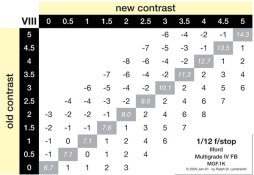Tom Stanworth
Member
- Joined
- Sep 4, 2003
- Messages
- 2,021
- Format
- Multi Format
One of the hardest things in printing IMO is to produce subtle high values without them blowing under lighting or looking leaden... while getting all your other values where you want them. I often find I have to go through the hassel of printing a number of shades, quick washing and then drying to allow me to observe the subtle variations that seem to have a huge effect on the balance of the final print.
When I print a number of slight variations I often find myself becoming blind to the changes in highlihgt density when observing the wet images in the tray. The ability to distinguish the variations in highlght density comes back when I take time away from the prints and the lights and see them afresh. Does anyone else find they become snow blind when working on prints with lots of high key tones, or bright subtle highlights?
I often find myself printing lighter and lighter only to find that the later, lighter prints, ended up too light. I invariably find the earlier (more dense) prints (printed according to values ascertained from dried test prints) were spot on and I keep getting led astray by what my eyes tell me when the prints are wet. Note that this is the opposite of drydown i.e. my eyes somehow imagine/see more density than is really there with the wet prints.
When I print a number of slight variations I often find myself becoming blind to the changes in highlihgt density when observing the wet images in the tray. The ability to distinguish the variations in highlght density comes back when I take time away from the prints and the lights and see them afresh. Does anyone else find they become snow blind when working on prints with lots of high key tones, or bright subtle highlights?
I often find myself printing lighter and lighter only to find that the later, lighter prints, ended up too light. I invariably find the earlier (more dense) prints (printed according to values ascertained from dried test prints) were spot on and I keep getting led astray by what my eyes tell me when the prints are wet. Note that this is the opposite of drydown i.e. my eyes somehow imagine/see more density than is really there with the wet prints.










 )
)
